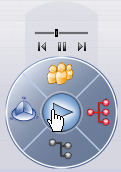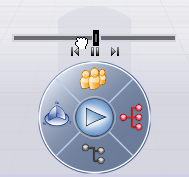Play | ||||
|
| |||
In the Compass, click Play
 .
.The currently selected objects are rotated, one by one, in such a way as to simulate an animation, thus allowing you to view them from multiple perspectives. If no object was selected, the entire set of visible objects is rotated together. The animation continues until you click again anywhere on the Compass.
A control bar appears that enables you to control the animation:

- The Previous arrow moves the animation to the previous object from among those objects that are being animated. (If no object was selected, the visual representation visit is restarted.)
- The Next arrow moves the animation to the next object from among those objects that are being animated. (If no object was selected, the visual representation visit is restarted.)
- The Pause button enables you to pause the animation. The Pause button located in the center pauses the animation and reselecting it continues the animation.
- The slider enables you to place the animation at any given point of its trajectory. The slider allows the user to directly control the visit (speed, position). When the user drags the slider, its size increases, thereby allowing the user to manipulate it more precisely.
If no objects are selected, the visual representation visit is around the entire set of visible objects taken as an entity. It begins by a Fit All In to show the whole scene, goes through six standard views (top, front, left, back, right, bottom, then goes back to the original viewpoint. It cycles until you deactivate the Play button.
If only one object is selected, the visual representation visit is around the selected object. All the other objects become transparent, the viewpoint zooms on the selected object, rotates around it and go back to the original viewpoint. It cycles until you deactivate the Play button.
If several objects are selected, the visual representation visit is around each of the selected objects one by one. The Previous Step and Next Step buttons allow the user to go from one object to another. The Play cycles until you deactivate the Play button.
If a quadrant is active when you click Play, the shading and labels are kept during the visit.
Important: Intermediate nodes are never attributed shadings, therefore during a visual representation visit they will always have their natural rendering. Click the Next arrow.
The next object from among those selected is animated.
Click the Pause button.
The animation is stopped in-place.
Tip: It is recommended that you pause the animation before trying to take control of the slider. Click the slider.
The slider is enlarged for maximum control.

Drag the slider.
You move the animation to various incremental points of its trajectory.
Click anywhere on the Compass.
The Play is deactivated. Note: The Play button is not active in Search Results.